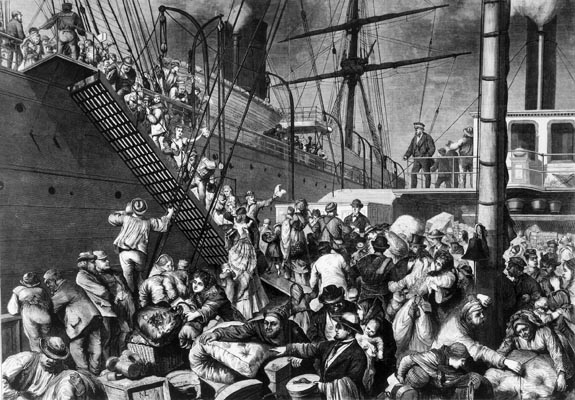If you see this after your page is loaded completely, leafletJS files are missing.
By Olaf Bernau
_ _ _
In 2005, the German Emigration Center opens in Bremerhaven. After all, of the more than 50 million Germans who left their homeland by ship between 1607 and 1970, 7.2 million people made the journey from Bremerhaven – most to North, Central and South America, a few to Australia and New Zealand.

The motives for emigration are quite different: lack of prospects in the wake of poverty and hunger may have been the most important. But there are other reasons as well: At 17. and The 18th century is about religious freedom, especially Protestants face discrimination in Catholic areas. At In the 19th century, political motives came to the fore: after the failed revolution of 1848/49, many liberals and democrats left the country, among them many Jews who had hoped in vain for social emancipation. At In the 20th century, National Socialism proved to be a caesura: after the Second World War, numerous survivors of the Shoah and former forced laborers went overseas. The Auswandererhaus wants to make these stories comprehensible. Therefore, there are not only detailed replicas, for example, of the interior of the ships. Individual biographical fates are also reconstructed using multimedia. In 2012 and 2021, the exhibition was expanded in each case, and now it also covers 330 years of immigration history to Germany. Thus, in the “Hall of Debates” conflicts around integration are presented. In this way, the resistance of those refugees and migrants who have fought for dignity and equal rights in countless local struggles over the past decades also comes into view. This multiplication of viewpoint is important, but it is not enough. Rather, it would be necessary to also address the issue of migration in other regions of the world. Because
much is unknown in Europe, which in turn leads to distortions in social debates. For example, when the image is repeatedly used that half of Africa is sitting on packed suitcases. In contrast, it is true that in migrant priority regions such as West Africa, just 2.6 percent of all people live outside their country of birth, and of these 2.6 percent, a good three-quarters are on the move in one of their respective neighboring countries. It is therefore not surprising that Europe is home to only 4.1 million people who were born in a sub-Saharan African country And the same applies to global migration movements, 86 percent of which took place in the Global South in 2020.
~
Sources:
Olaf Bernau (2022): Brennpunkt Westafrika. The causes of flight and what Europe should do. Munich: C.H.Beck
The Columbus Quay (2015): Bremerhaven’s emigrant quay. Mysterious Places (ARD documentary, 43 minutes). URL: https://www.youtube.com/watch?v=wLpsDrD3P_g (accessed: 20.02.2022)
Sebastian Möller (2020): The Ports of Bremen in the Global Political Economy. Research seminar at the University of Bremen (SoSe 2020). URL: https://blogs.uni-bremen.de/hafenblog/ (accessed: 20.02.2022)
Jan Plamper (2019): The New Us. Why migration is part of it. Another history of the Germans. Frankfurt am Main: Fischer
